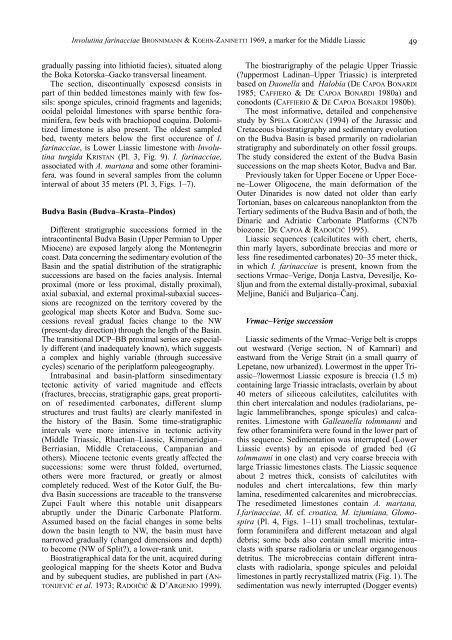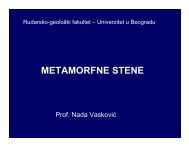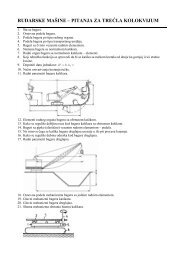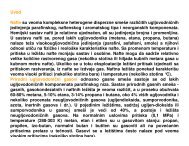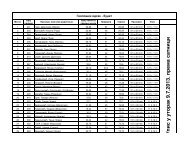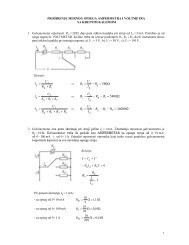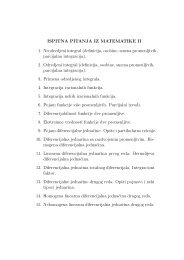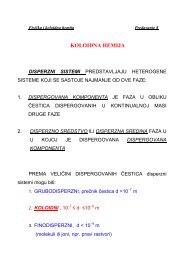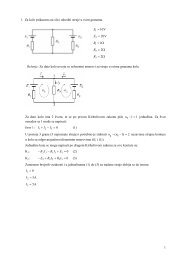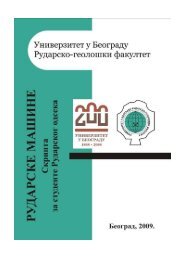KÑига LXXII
KÑига LXXII
KÑига LXXII
You also want an ePaper? Increase the reach of your titles
YUMPU automatically turns print PDFs into web optimized ePapers that Google loves.
Involutina farinacciae BRONNIMANN & KOEHN-ZANINETTI 1969, a marker for the Middle Liassic 49<br />
gradually passing into lithiotid facies), situated along<br />
the Boka Kotorska–Gacko transversal lineament.<br />
The section, discontinually exposesd consists in<br />
part of thin bedded limestones mainly with few fossils:<br />
sponge spicules, crinoid fragments and lagenids;<br />
ooidal peloidal limestones with sparse benthic foraminifera,<br />
few beds with brachiopod coquina. Dolomitized<br />
limestone is also present. The oldest sampled<br />
bed, twenty meters below the first occurence of I.<br />
farinacciae, is Lower Liassic limestone with Involutina<br />
turgida KRISTAN (Pl. 3, Fig. 9). I. farinacciae,<br />
associated with A. martana and some other foraminifera,<br />
was found in several samples from the column<br />
interwal of about 35 meters (Pl. 3, Figs. 1–7).<br />
Budva Basin (Budva–Krasta–Pindos)<br />
Different stratigraphic successions formed in the<br />
intracontinental Budva Basin (Upper Permian to Upper<br />
Miocene) are exposed largely along the Montenegrin<br />
coast. Data concerning the sedimentary evolution of the<br />
Basin and the spatial distribution of the stratigraphic<br />
successions are based on the facies analysis. Internal<br />
proximal (more or less proximal, distally proximal),<br />
axial subaxial, and external proximal-subaxial successions<br />
are recognized on the territory covered by the<br />
geological map sheets Kotor and Budva. Some successions<br />
reveal gradual facies change to the NW<br />
(present-day direction) through the length of the Basin.<br />
The transitional DCP–BB proximal series are especially<br />
different (and inadequately known), which suggests<br />
a complex and highly variable (through successive<br />
cycles) scenario of the periplatform paleogeography.<br />
Intrabasinal and basin-platform sinsedimentary<br />
tectonic activity of varied magnitude and effects<br />
(fractures, breccias, stratigraphic gaps, great proportion<br />
of resedimented carbonates, different slump<br />
structures and trust faults) are clearly manifested in<br />
the history of the Basin. Some time-stratigraphic<br />
intervals were more intensive in tectonic activity<br />
(Middle Triassic, Rhaetian–Liassic, Kimmeridgian–<br />
Berriasian, Middle Cretaceous, Campanian and<br />
others). Miocene tectonic events greatly affected the<br />
successions: some were thrust folded, overturned,<br />
others were more fractured, or greatly or almost<br />
completely reduced. West of the Kotor Gulf, the Budva<br />
Basin successions are traceable to the transverse<br />
Zupci Fault where this notable unit disappears<br />
abruptly under the Dinaric Carbonate Platform.<br />
Assumed based on the facial changes in some belts<br />
down the basin length to NW, the basin must have<br />
narrowed gradually (changed dimensions and depth)<br />
to become (NW of Split?), a lower-rank unit.<br />
Biostratigraphical data for the unit, acquired during<br />
geological mapping for the sheets Kotor and Budva<br />
and by subequent studies, are published in part (AN-<br />
TONIJEVIĆ et al. 1973; RADOIČIĆ & D’ARGENIO 1999).<br />
The biostrarigraphy of the pelagic Upper Triassic<br />
(?uppermost Ladinan–Upper Triassic) is interpreted<br />
based on Daonella and Halobia (DE CAPOA BONARDI<br />
1985; CAFFIERO & DE CAPOA BONARDI 1980a) and<br />
conodonts (CAFFIERIO & DE CAPOA BONARDI 1980b).<br />
The most informative, detailed and conpehensive<br />
study by ŠPELA GORIČAN (1994) of the Jurassic and<br />
Cretaceous biostratigraphy and sedimentary evolution<br />
on the Budva Basin is based prmarily on radiolarian<br />
stratigraphy and subordinately on other fossil groups.<br />
The study considered the extent of the Budva Basin<br />
successions on the map sheets Kotor, Budva and Bar.<br />
Previously taken for Upper Eocene or Upper Eocene–Lower<br />
Oligocene, the main deformation of the<br />
Outer Dinarides is now dated not older than early<br />
Tortonian, bases on calcareous nanoplankton from the<br />
Tertiary sediments of the Budva Basin and of both, the<br />
Dinaric and Adriatic Carbonate Platforms (CN7b<br />
biozone: DE CAPOA & RADOIČIĆ 1995).<br />
Liassic sequences (calcilutites with chert, cherts,<br />
thin marly layers, subordinate breccias and more or<br />
less fine resedimented carbonates) 20–35 meter thick,<br />
in which I. farinacciae is present, known from the<br />
sections Vrmac–Verige, Donja Lastva, Devesilje, Košljun<br />
and from the external distally-proximal, subaxial<br />
Meljine, Banići and Buljarica–Čanj.<br />
Vrmac–Verige succession<br />
Liassic sediments of the Vrmac–Verige belt is cropps<br />
out westward (Verige section, N of Kamnari) and<br />
eastward from the Verige Strait (in a small quarry of<br />
Lepetane, now urbanized). Lowermost in the upper Triassic–?lowermost<br />
Liassic exposure is breccia (1.5 m)<br />
containing large Triassic intraclasts, overlain by about<br />
40 meters of siliceous calcilutites, calcilutites with<br />
thin chert intercalation and nodules (radiolarians, pelagic<br />
lammelibranches, sponge spicules) and calcarenites.<br />
Limestone with Galleanella tolmmanni and<br />
few other foraminifera were found in the lower part of<br />
this sequence. Sedimentation was interrupted (Lower<br />
Liassic events) by an episode of graded bed (G.<br />
tolmmanni in one clast) and very coarse breccia with<br />
large Triassic limestones clasts. The Liassic sequence<br />
about 2 metres thick, consists of calcilutites with<br />
nodules and chert intercalations, few thin marly<br />
lamina, resedimented calcarenites and microbreccias.<br />
The resedimeted limestones contain A. martana,<br />
I.farinacciae, M. cf. croatica, M. izjumiana, Glomospira<br />
(Pl. 4, Figs. 1–11) small trocholinas, textularform<br />
foraminifera and different metazoan and algal<br />
debris; some beds also contain small micritic intraclasts<br />
with sparse radiolaria or unclear organogenous<br />
detritus. The microbreccias contain different intraclasts<br />
with radiolaria, sponge spicules and peloidal<br />
limestones in partly recrystallized matrix (Fig. 1). The<br />
sedimentation was newly interrupted (Dogger events)


